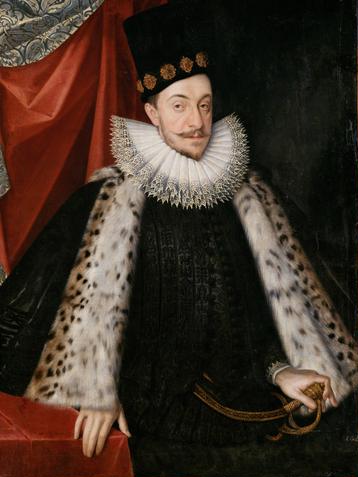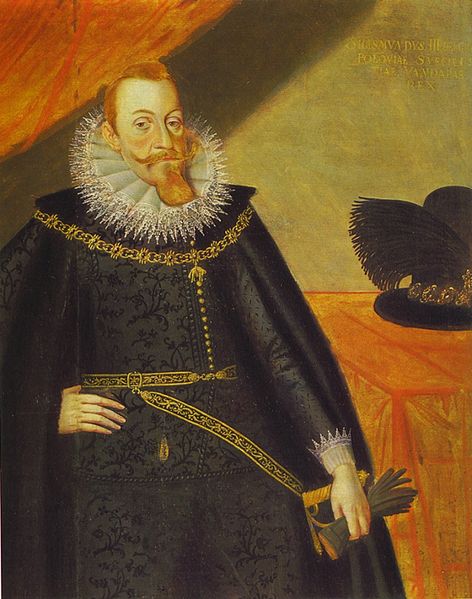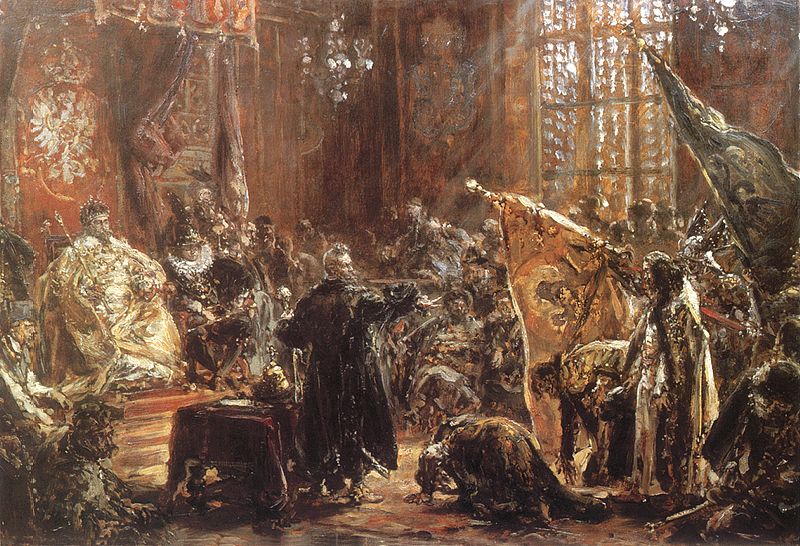<Back to Index>
- Educator Moses Waddel, 1770
- Painter Salvator Rosa, 1615
- King of Poland Sigismund III Vasa, 1566
PAGE SPONSOR


Sigismund III Vasa, Polish: Zygmunt III Waza, (20 June 1566 – 30 April 1632 N.S.) was King of Poland and Grand Duke of Lithuania, a monarch of the united Polish - Lithuanian Commonwealth from 1587 to 1632, and King of Sweden (where he is known simply as Sigismund) from 1592 until he was deposed in 1599. He was the son of King John III of Sweden and his first wife, Catherine Jagellonica of Poland.
Elected to the throne of the Polish - Lithuanian Commonwealth, Sigismund sought to create a personal union between the Commonwealth and Sweden (Polish - Swedish union), and succeeded for a time in 1592. After he had been deposed in 1599 from the Swedish throne by his uncle, Charles IX of Sweden, and a meeting of the Riksens ständer (Swedish Riksdag),
he spent much of the rest of his life attempting to reclaim it.
Sigismund remains a highly controversial figure in Poland. His long
reign coincided with the apex of the Polish - Lithuanian Commonwealth's prestige, power and economic influence.
On the other hand, it was also during his reign that the symptoms of
decline that led to the Commonwealth's future demise surfaced. Common
views, influenced by popular books of Paweł Jasienica, tend to present Sigismund as the main factor responsible for initiating
these negative processes, while academic historians usually are not
that condemning. However, the question whether the Commonwealth's
decline was caused by Sigismund's own decisions or its roots were in
historical processes beyond his personal control, remains a highly
debated topic. He was commemorated in Warsaw with Zygmunt's Column, commissioned by his son and successor, Władysław IV. Sigismund
was elected King of Poland and reigned 1587 - 1632. By paternal
inheritance, he also succeeded in 1592 as King of Sweden but was
regarded as having abdicated there in 1599 and finally deposed in 1604.
From his grandmother Bona Sforza he inherited the title of King of Jerusalem. He was born at Gripsholm during his parents' imprisonment by King Eric XIV. Although Sweden was Protestant, Sigismund was raised a Catholic, the religion of his mother. This fact, combined with the troublesome personal union, would later strike back at his attempts to find support in Sweden. His mother, Katarzyna Jagiellonka, was the daughter of Sigismund I the Old and his wife Bona Sforza. The Jagiellon dynasty had held the crown of the Polish - Lithuanian Commonwealth since the first Jagiellon ruler, Władysław II Jagiełło, had received it in 1386 through his wife Jadwiga Angevin. In 1587, he was a candidate for the monarch of Polish - Lithuanian Commonwealth, following the death of the previous Polish king, Stefan Batory. The election was held in the shadow of conflict between the Polish nobility (szlachta), with the two opposing sides gathered around Chancellor Jan Zamoyski and the Zborowski family. Sigismund, supported by Zamoyski and the former king's wife, Anna Jagiellon, was elected King of the Polish - Lithuanian Commonwealth on 19 August 1587 and recognized as such by the interrex, the Primate of Poland, Stanisław Karnkowski. However, the election was disputed by the other candidate, Maximilian III of Austria,
and opponents of Sigismund chose not to respect the election outcome,
decreeing that Maximilian was the rightful monarch. Neither Sigismund
nor Maximilian were present in the Commonwealth at that time. After
receiving news of his election, Sigismund quickly departed from Sweden
and arrived in Oliwa on 7 October (his landing was delayed due to the hostility from the Protestant Gdańsk). In his Pacta conventa Sigismund accepted a reduction of monarchal power in favour of the Sejm (Commonwealth parliament), which in all probability marked the beginning of the decline of the Commonwealth and the end of Poland as a great power of the era. Lesser Prussian Treasurer Jan Dulski representing the Crown Marshall Andrzej Opaliński proclaimed
him to be the king. Sigismund returned to his ship on the same day,
arriving in Gdańsk the next day, and after approximately two weeks he had
departed to Kraków, where he was crowned on 27 December of that year. When Maximilian attempted to resolve the dispute by bringing a military force and starting the war of Polish succession, he was defeated at the battle of Byczyna by the supporters of Sigismund, under the command of Polish hetman Jan Zamojski. Maximilian was taken captive and released only after intervention by Pope Sixtus V. In 1589, he waived his right to the Polish crown. In
1592 he married the Austrian archduchess Anna of Austria (1573 – 1598)
Anna Habsburzanka and after his father's death the same year, he
received permission from the Sejm to accept the Swedish throne. After Sigismund promised to uphold Swedish Lutheranism he was crowned king of Sweden in 1594; for a short time there was a personal union between the Commonwealth and Sweden (Polish - Swedish union). He tried to rule Sweden from Poland, leaving Sweden under control of a regent, his paternal uncle Duke Charles. In 1596 he succeeded in creating the Union of Brest, which attempted to bring part of the Orthodox religion into Catholicism. In the same year he transferred the capital of Poland from Kraków to Warsaw. After his wife Anna died in 1598, he married her sister Constance of Austria in
1605. Troubles were growing on the southern border of the Commonwealth,
where Jan Zamoyski and other magnates were engaged in the Magnate wars in Moldavia. Eventually after the defeat of Polish forces in the battle of Cecora in 1620 the Commonwealth had to relinquish its claims to the Principality of Moldavia. Due to Sigismund's strong support of the Counter Reformation,
his support in largely Protestant Sweden eroded quickly. Charles soon
took full control of Sweden and rebelled against Sigismund, ostensibly
due to fears that Sigismund might re-Catholicize Sweden. In 1598
Sigismund tried to defeat him with a mixed army from Sweden and Poland
but was defeated at the Battle of Stångebro.
Sigismund was forbidden to rule Sweden from abroad but nevertheless
returned to Poland, and so in 1599 was deposed. This and his decision
to incorporate Livonia into the Commonwealth led to the Polish - Swedish War,
which lasted, with minor breaks, to 1629. The war ended with Sweden
gaining Livonia. The kingship was ultimately ceded to Charles.
Sigismund, however, did not relinquish his claim to the Swedish throne,
and his subsequent foreign policy was aimed at regaining the Swedish
crown. This led to bitter relations and several wars between the two
countries, to end only after the Great Northern War. In 1605 Sigismund attempted to strengthen the monarch's power by asking the Sejm (the Polish - Lithuanian Commonwealth's parliament) to limit the liberum veto, increase taxes, and augment the military. His opponents, led by Mikołaj Zebrzydowski, declared a confederation and rokosz at Sandomierz, leading to a civil war known as rokosz Zebrzydowskiego (Zebrzydowski's Rebellion). Eventually, royalist forces defeated the rokoszans on 6 July 1607 at the Battle of Guzów, but the eventual compromise was a return to the status quo ante from before 1605. Another important conflict in his reign was the Polish - Muscovite War (1605 - 1618), also known as The Dymitriads. Sigismund and many Polish magnates attempted to exploit the Muscovite civil war (the Time of Troubles), and after a lengthy war the 1618 Truce of Deulino gave some territorial concessions to the Commonwealth (mainly the Smoleńsk Voivodship). Nonetheless, this war increased tensions between Poland and Russia, and ruined the prospects for a Polish - Lithuanian - Muscovite Commonwealth. Sigismund
was a talented painter and goldsmith: of his three paintings that
survive until the present day one was for centuries erroneously attributed to Tintoretto; from his workshop came the main part of the famous silver coffin of St. Adalbert of Prague at the Cathedral in Gniezno. Sigismund died at the age of 65 in the Royal Castle in Warsaw. Many
historians believe that Sigismund viewed Poland only as a tool that
would allow him to eventually regain the throne of Sweden. To this end
he tried to strengthen his royal power and allied himself with Habsburgs and Counter - Reformation forces. Those politics were opposed by many in the Polish nobility (the szlachta), most notably the chancellor Jan Zamojski. This led to a semi-legal rebellion against the king (rokosz), known as rokosz of Zebrzydowski (1606 – 1608), which was a response to Sigismund's attempt to introduce majority voting in place of unanimity in
the Sejm. Eventually Sigismund's loyalist forces were victorious, but
the rebels went unpunished. Partially in order to pacify the restless
szlachta, Sigismund supported war with Muscovy (the Dimitriads,
1608 – 1618). Although the Commonwealth forces were almost constantly
shuffled between wars in the East (with Muscovy), north (with Sweden)
and South (with Ottomans - the Polish - Ottoman wars), Sigismund took advantage of the civil war in Russia (the Time of Troubles) and secured temporary territorial gains for the Commonwealth. While Sigismund never managed to regain the Swedish throne, his politics of personal ambition did succeed in provoking a long series of conflicts between the Commonwealth and Sweden and Muscovy. While the Commonwealth Sejm managed
to thwart many ambitious (and dangerous) offensive plans of Sigismund
(and later of his son, Wladislaw), the Vasa dynasty nonetheless
succeeded in partially drawing the Commonwealth into the Thirty Years' War.
This senseless conflict with Sweden, combined with wars against
Ottomans and Muscovy, eventually culminated well after Sigismund's
death in the series of events known as The Deluge, which ended the Golden Age of the Commonwealth. During his reign he allowed the Brandenburg Hohenzollerns to inherit Ducal Prussia.
